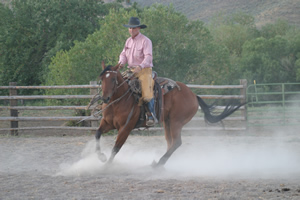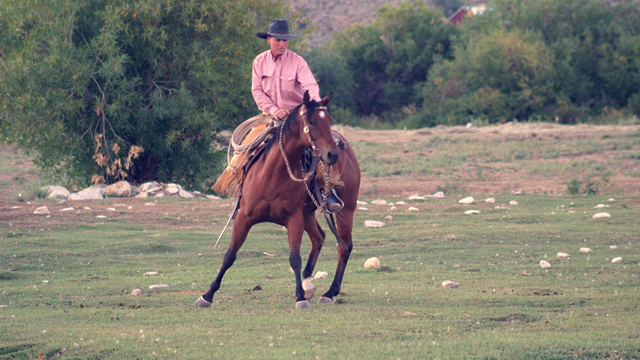This article originally appeared in Eclectic Horseman Issue No.16
 Riders usually get their horses turned around one way or another, but few really get things worked out to where the horse stays balanced and really uses the whole body to execute the maneuver.
Riders usually get their horses turned around one way or another, but few really get things worked out to where the horse stays balanced and really uses the whole body to execute the maneuver.
Some horses reach and use their front end good, but with speed the hindquarters step outside while turning. Others pull with the hindquarters good, but the front end doesn’t reach, so it ends up hopping or offsetting around. If the rider pulls too hard on the reins, one of two things happen: the horse stays supple and his neck will bend too much so he can’t balance himself in a way to compliment the turn, or the horse resists the pull, gets rigid and the neck gets too straight. Then the head is elevated too much for a balanced turn.
When the horse’s eye looks into the turn, his poll will tip to the inside. When the poll is supple and bends, the loin will also slightly bend simultaneously. This helps engage the hindquarters and balance the front end. If the rider kicks or spurs the outside ribs or shoulder too much, the horse may try to position his head so his eye can look back at the rider’s foot, which would mean the horse is too straight. Or the horse’s head may be pulled to the inside, but the muscles over the ribs would be tight, anticipating and bracing against the rider kicking. In either case, the poll is not going to be bent and the horse is not going to use himself to his maximum potential. And if the rider is interfering with the horse’s balance or causing the horse to tighten muscles when they need to be supple, the horse will not achieve his potential.
Turning a horse is a balancing act, figuratively and literally. The horse may have anywhere from one to all four feet contacting the ground while in an accelerated motion. This obviously requires balance, to position their weight to counter gravitational force, and in another sense of the word, to have symmetrical use between the hindquarters and hind feet, the shoulders and front feet and, of course, the head and neck. If any one of these parts isn’t in the proper position, the horse will be handicapped. So we need a balance of the use and position of each part influencing the turn. It doesn’t matter so much what order we prepare the different parts; what matters is that they all come together and create balance in every sense of the word.
There are different styles and purposes for a turnaround and it’s important to understand, for your sake and the horse’s sake, what exactly it is you want to accomplish. To clarify, for argument sake, the type of turnaround we are discussing is a flat spin with consistent speed and uniform motion, traveling the same for one revolution or ten, just as though you would lope one circle or ten.
Horse racing history has established the simple fact that a horse’s forward motion is faster than a horse’s reverse motion. With this fact the horse can turn in a forward motion, pivoting and pulling back with the inside hind foot to hold himself consistently centered, and the outside hind and both front feet in a forward motion. This type of turn will give you the most speed with the power coming from the inside hind pulling back, against the other three quarters pulling forward, utilizing centrifugal force to speed the turnaround.
Trotting circles is an exercise that can be used to get the front end to reach over with an accelerated pace. When the horse can spiral down from a larger circle until the inside hind foot pivots and the front feet are in a trotting speed, that would be a fair pace for a turnaround.
An exercise to get the hindquarters to pull is a rollback, where the horse would use his hindquarters to pull the front end off the ground and set it over a quarter or half turn, then let the horse move straight forward again. Allowing the horse to move forward without pulling or kicking gives him a step or so to rebalance and then set him in another turn.
A horse can learn to prepare both ends with these simple exercises by simply getting the front end to reach freer, or getting the hind end to pull more. The right amount of forward motion will get the outside hind going forward while the inside hind pulls back. If the rider can maintain a light contact on the reins so the head position isn’t altered, and both front and hindquarters contributing appropriately, a smooth turnaround will be the result.
Backing a horse in circles is commonly used to influence a horse to pull with the hindquarters, but it is ineffective if the horse is backing using the front end to push the hind, instead of using the hind to pull the front, or if the horse is backing while trying to turn and tangling up and or stepping out behind. Regardless of the method, it’s good judgment, understanding with proper preparation, or luck that is essential to good results, and recognizing the difference will save you some grief.
This article originally appeared in Eclectic Horseman Issue No.16
https://eclectic-horseman.com/mercantile/horse-training-dvds/fundamental-horse-training/martin-black-roundpen-to-arena-part-3-refinement/


